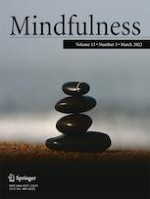05-02-2022 | ORIGINAL PAPER
Validation and Factor Structure of the Mindfulness-Based Self Efficacy Scale-Revised
Gepubliceerd in: Mindfulness | Uitgave 3/2022
Log in om toegang te krijgenAbstract
Objectives
The initial version of the Mindfulness-based Self-Efficacy Scale (MSES) was constructed to assess changes in the perception of self-efficacy in clinical populations undertaking mindfulness training as part of therapy. Although it has been used increasingly since its subsequent revision a decade ago, the factor structure of this 22-item revised version (MSES-R) has not yet been confirmed. The current study investigated the factor structure and measurement invariance of the MSES-R in heterogenous clinical samples, and sensitivity to change over the course of a mindfulness-based therapy program.
Methods
Confirmatory factor analysis was performed on the MSES-R scores collected online from two Australian samples (clinical N = 1378; community N = 2866), two Canadian samples (clinical N = 595; community N = 321), and one Australian university student sample (N = 521). Other questionnaires were used to further assess convergent and discriminant validity.
Results
The MSES-R provided adequate fit across all samples, although factors containing fewer items had low reliability. The MSES-R displayed scalar measurement invariance between the clinical and community Australian samples, and across the Australian and Canadian samples. Both community samples score significantly higher on the MSES-R than the clinical samples. In the student sample, respondents who regularly engaged in meditative or contemplative practices scored higher on the MSES-R than non-meditators. The MSES-R was also associated with higher scores on the Five Facet Mindfulness Questionnaire and with lower levels of psychological distress in the student sample. In a separate clinical sample (N = 68), MSES-R scores increased significantly over the duration of a 10-week mindfulness-based therapy.
Conclusions
The current findings provide additional evidence that the MSES-R is a useful addition to the battery of mindfulness-based assessment tools to investigate the efficacy and outcomes of mindfulness-based programs, including in clinical settings.
